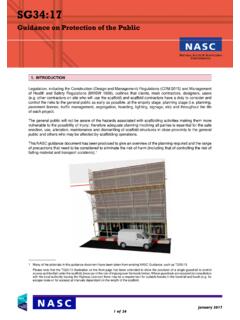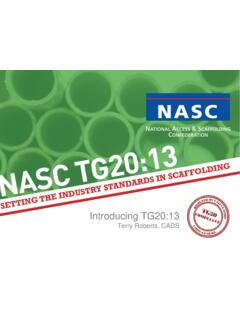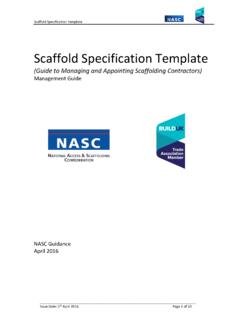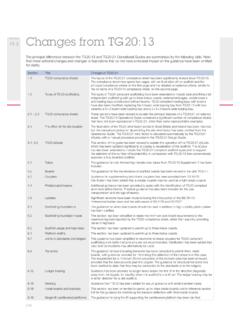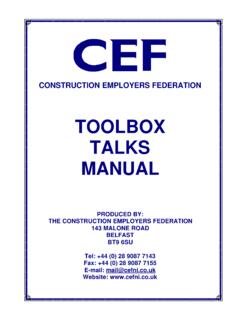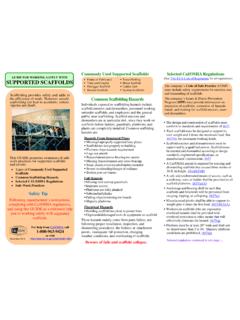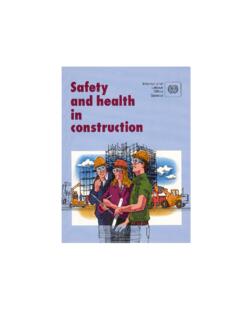Transcription of SG25:20 - NASC
1 NASC1 of 16SG25:20 Access and Egress from Scaffolding, via Ladders and Stair towers 20201. INTRODUCTIONThis document gives scaffolding companies and clients guidance on The Work at Height Regulations 2005 (WAHR 2005) relating to safe means of access to and from scaffolding working Construction (Design and Management) Regulations (CDM) outline that clients, principal designers, principal contractors, designers and contractors should consider what form of access may be needed at the planning stage. This should include any emergency escape routes that have been identified by the risk assessment, the preferred option for access / egress and the required number of access pointsOn larger projects powered passenger / goods hoists may be a safer option if available.
2 Where passenger hoists are used, an additional means of access will be required for emergency purposes ( in the event of a fire or mechanical failure).On existing buildings, it may be possible to use permanent staircases to gain access to the scaffolding; however, for many applications the starting point for consideration by the client should be an access staircase that can be adapted to suit all scaffolding types, followed by ladder access towers or bays (see Figure 1 and 2). 132 Staircase towers are the preferred method of accessing a scaffold whenever a permanent access route is towers may be built from tubes and fittings, with the treads formed from scaffold boards or prefabricated components. However, such staircases are rarely used now because of the prevalence of proprietary staircase staircase towersIf a proprietary staircase is used the manufacturer s instructions and specifications must be followed.
3 These should include instructions for the erection, alteration and dismantling of the equipment, and the maximum safe height of the staircase, with or without sheeting or stair tower should be set out carefully to ensure it is as close to the main access scaffolding as practically should be taken when planning the platform heights of proprietary stair towers used to access tube and fitting scaffolding to ensure the platform heights of the tower align with the working platforms of the main scaffolding as closely as stair towers should be physically tied or stabilised to the permanent structure or scaffolding structure, following the guidance of the and escape staircasesIf it is necessary to provide a stair tower for public access or escape it will be subject to engineering design in all stair towers must be fit for purpose and capable of withstanding the loads from a large number of people running down the stairs.
4 Specialist proprietary stair towers are typically used, such as illustrated by figure towers for public access or escape must comply with the relevant Building Regulations and the Regulatory Reform (Fire Safety) Order 2005 in England and Wales. The applicable regulations for Scotland and Northern Ireland are listed in section Documents B, K and M of the Building Regulations 2010 (which set the minimum standards for fire safety, fall protection and access to buildings) must be complied with. If it is not practicable to do so, it is advisable for the client to seek the agreement of the HSE and / or the Local fire safety guidance is provided in Part 2 of the HSE publication HSG 168: Fire safety in construction, information about which is provided on page 136 of this towersWhen fixing a proprietary staircase unit to a fa ade scaffold, lateral support against wind loads may be required, such as wing bracing and additional s guidance or design advice should be : a proprietary staircase : a proprietary public-access Volume 13203/02/2014 09:18.
5 42 Figure 1 Proprietary system scaffold stair tower Figure 2 Ladder access bay with single lift laddersNASC2 of 16 The WAHR 2005 state that ladders should only be used for work at height if a risk assessment under Regulation 3 of The Management of Health and Safety at Work Regulations 1999 has demonstrated that the use of more suitable work equipment ( a staircase) is not justified because of the low risk and short duration of use, or there are existing features on site which cannot be equipment, including staircase components and ladders, must be inspected and maintained in compliance with the Provision and Use of Work Equipment Regulations 1998 (PUWER 1998) and all relevant British and European Standards, as well as any manufacturer s inspection such access solutions are not reasonably practicable, internal or external ladder access may have to be inspectors will expect all parties, including clients, principal designers, principal contractors, designers and contractors to give careful consideration to the various ways of achieving safe access and egress and all may be asked to explain the reasoning behind any of their decisions.
6 Principal contractors are now becoming more aware of the need to consider safer means of access to scaffolds and will increasingly be specifying stair towers and ladder access towers at various points on the NASC advises that access points should be no more than apart, subject to a suitable risk which need to be considered by clients, principal designers, principal contractors, designers and contractors regarding the assessment of suitable access and egress from scaffolds will include: Length, width and height of scaffolding; Number of people using the scaffolding at any one time; duration of scaffolding hire; Type of work to be undertaken on scaffolding ( access to confined space entry work and asbestos removal enclosures whilst using full face respirators etc.)
7 Requires a higher degree of assessment for access and egress); Emergency and evacuation requirements (Fire, Toxic Gas alarms etc.) may, for instance, require additional access points (and those that are easiest to use under pressure); Security issues to ensure access by authorised persons only; Access hazards to and from the scaffolding and also the access arrangements on scaffolding assess the risk of trip hazards where the standards protrude up past the boards on the top lift and, where required by the assessment, fix caps on tops of tubes or hemp up short tubes so that the standards are waist Hierarchy of Safe Access in Order of Preference:1 Staircases and Lifts in permanent structures2 Mechanical hoists for larger projects and where available (with additional emergency access), including hoists under the control of the scaffold contractor used for erection of scaffolding, then kept for other trades if required3 Temporary Staircase Towers4 Ladder Access Bays with Single Lift Ladders5 Ladder Access Bays with Multiple Lift Ladders6 Internal Ladder Accesses with Protection ( ladder trap hatch / handrails etc)7 External Ladder Accesses Using a Safety Gate / Swing Arm System8 OtherNASC3 of 162.
8 STAIRCASE TOWERST here are various Proprietary Staircases on the market to choose from. Scaffolding companies should ensure that the equipment that they plan to purchase or hire meets the requirements of the planned application and is compatible as necessary. There are alternative versions of original systems, which are visually similar. These systems can be constructed in unison providing the product attains the standard outlined in the NASC Code of Practice for Scaffolding Products . When mixing original systems with alternative versions, design input will be required and the scaffold should be erected to the lower capacity specification. Note: The NASC strongly recommend the use of staircases over ladders as they are a safer method of access, enable some material to be safely manual handled, and allow easier evacuation and emergency service specifiers call for staircase towers to be fully sheeted in order to increase security and reduce discomfort on windy days.
9 However, please note that current guidance (HSG168) recommends that any staircase tower that ALSO functions as a fire escape should not be sheeted. Where clients and / or principal contractors include the staircase tower(s) as part of their fire emergency route, they should inform the scaffolding contractor at design / pre-tender stage and arrange, if required by the client / principal contractor s risk assessment, for the scaffold contractor to fix additional measures if needed ( additional guardrails and toe boards). Where the client, principal contractor, designer and / or contractor requires toeboards on the landings of system staircases this should be stipulated at design / pre tender stage, as retrospectively fitting toeboards after the staircase has been erected is very expensive in terms of man hours and cost.
10 Similarly, where the client, principal contractor, designer and / or contractor requires additional guardrails at chest height on the outside standards to make staircase users feel more comfortable and caged in as they walk up and down, this again should be stipulated at design / pre tender stage, to reduce practical, staircase flights and landings should align where the tower connects with scaffold lifts to reduce as much as possible the need to step up or down onto the proprietary staircase equipment is hired or purchased, manufacturer s instructions, user guide and specifications must be provided to the hirer or should have received appropriate training in accordance with the manufacturer s standards for the proprietary stair system which, as a minimum, should cover the erection, altering or dismantling of the equipment.


